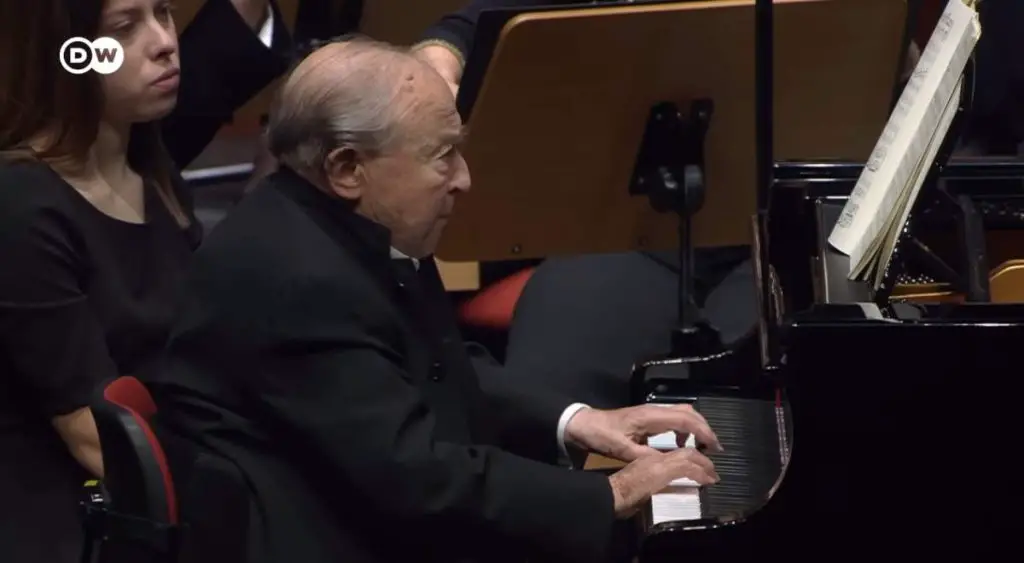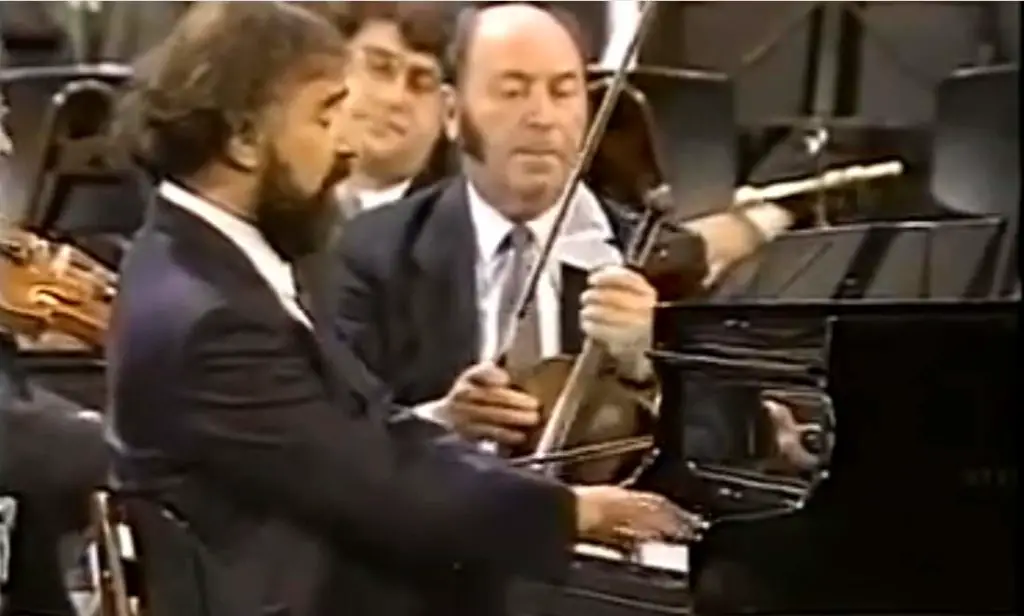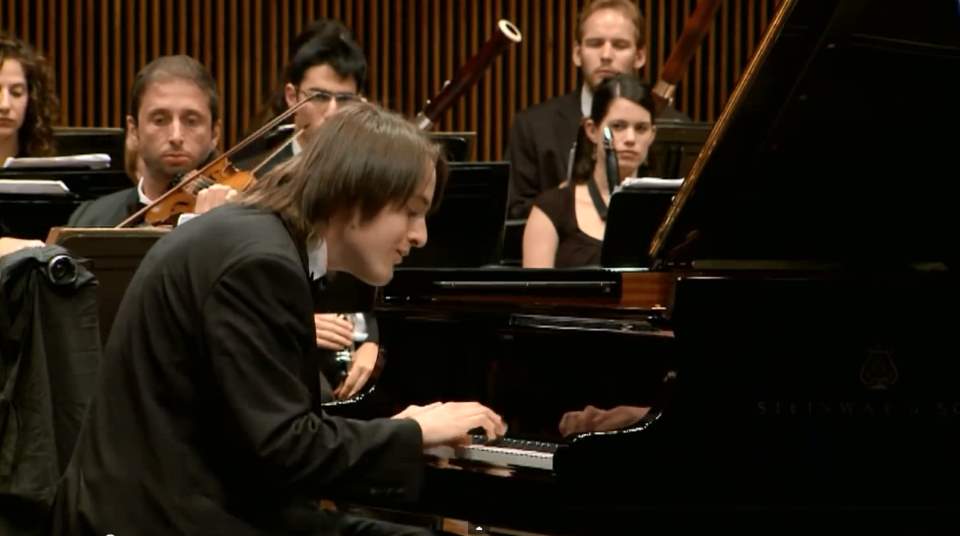Accompanied by the hr-Sinfonieorchester (Frankfurt Radio Symphony Orchestra), the Japanese pianist Mao Fujita performs Wolfgang Amadeus Mozart’s Piano Concerto No. 23 in A major (K. 488). Conductor: Dalia Stasevska. This performance was recorded at the hr-Sendesaal Frankfurt on April 19, 2024.
Wolfgang Amadeus Mozart’s Piano Concerto No. 23
Mozart’s Piano Concerto No. 23 in A major, K. 488, is one of his most celebrated works, composed in 1786 during a particularly prolific period in his career. This concerto was completed on March 2, 1786, just a few months before the premiere of his opera “The Marriage of Figaro.”
It was likely performed by Mozart himself at one of his subscription concerts in Vienna, where he often showcased his latest compositions. The concerto is scored for a relatively small orchestra, including a flute, two clarinets, two bassoons, two horns, and strings, which allows for a delicate interplay between the piano and the orchestra. This instrumentation is notable because it includes clarinets, which were relatively new to orchestral music at the time, and adds a unique color to the overall sound.
The concerto is renowned for its lyrical beauty and the seamless integration of the piano with the orchestral texture. Unlike some of Mozart’s earlier concertos, where the piano often takes a more dominant role, in this piece, the piano and orchestra engage in a more balanced dialogue. This creates a sense of intimacy and conversational exchange that is both charming and sophisticated. The concerto’s themes are memorable and exhibit Mozart’s characteristic elegance and grace, with moments of both exuberance and introspection. It has been praised for its expressive depth and the way it captures a wide range of emotions, from joy to melancholy.
Over the years, Piano Concerto No. 23 has become a staple of the classical piano repertoire, beloved by performers and audiences alike. Its enduring popularity is a testament to Mozart’s genius in crafting music that is both technically demanding and deeply moving. The concerto continues to be performed regularly in concert halls around the world, maintaining its status as a masterpiece of the classical era.
Movements
There are three movements. With the start times in the video:
- Allegro 00:00
- Adagio 12:02
- Allegro assai 19:05
1. Allegro
The first movement of Mozart’s Piano Concerto No. 23 is marked “Allegro.” It opens with a delicate orchestral introduction, where the main themes are presented. The music is characterized by a light, joyful mood, with the strings and woodwinds blending seamlessly to create a warm, inviting atmosphere. The themes Mozart introduces here are simple yet deeply expressive, with a sense of grace and refinement typical of his mature style.
When the piano enters, it picks up these themes, elaborating on them with intricate ornamentation and virtuosic passages. Mozart’s writing for the piano is both playful and expressive, showcasing the instrument’s ability to convey a wide range of emotions. The dialogue between the piano and the orchestra is particularly striking, as they pass the themes back and forth, each adding their own nuances.
Structurally, the movement follows the classical sonata form, with an exposition, development, and recapitulation. However, Mozart’s genius lies in how he handles this form, allowing the music to flow naturally while maintaining a clear structure.
The movement concludes with a light and lively coda, bringing the joyful spirit of the piece to a satisfying close. It’s a perfect example of Mozart’s ability to combine technical brilliance with profound musical expression.
2. Adagio
The second movement of Mozart’s Piano Concerto No. 23 is marked Adagio and is one of the most sublime and introspective pieces Mozart ever composed. Set in F-sharp minor, an unusual key for the time, the movement contrasts sharply with the bright and lively first movement, offering a deeply emotional and contemplative experience.
The movement opens with a serene and somewhat melancholic theme introduced by the piano, accompanied softly by the strings. This theme is lyrical and flowing, with a sense of calmness, but also carries an undercurrent of sadness. Mozart’s choice of F-sharp minor adds to the movement’s poignancy, as it was a rare and expressive key in the Classical era.
As the movement progresses, the piano continues to weave intricate, expressive melodies, with the orchestra providing a delicate, supportive backdrop. The interplay between the piano and orchestra is intimate and subtle, with the piano often leading and the orchestra responding in gentle echoes.
The Adagio is structured as a simple ternary form (A-B-A), with the central section offering a contrasting theme that is slightly more hopeful, yet still retains the overall reflective mood. The return of the opening theme brings back the movement’s introspective quality, and the piece ends quietly, with a sense of resignation and calm acceptance.
This movement is a showcase of Mozart’s ability to convey deep emotion with simplicity and elegance, making it a profound and moving centerpiece of the concerto.
3. Allegro assai
The third movement of Mozart’s Piano Concerto No. 23, marked Allegro assai, is a lively and spirited finale that brings the concerto to a joyful and energetic conclusion. This movement is a rondo, a popular form for final movements during the Classical period, characterized by a recurring main theme interspersed with contrasting episodes.
The main theme, introduced by the piano, is playful and buoyant, full of rhythmic vitality and melodic charm. This theme recurs throughout the movement, each time bringing a sense of familiarity and unity. The orchestra complements the piano with bright, light textures, creating an atmosphere of celebration.
Between the appearances of the main theme, Mozart introduces contrasting episodes that explore different moods and keys. These sections are often more lyrical or dramatic, providing a rich contrast to the spirited main theme. The piano’s role in these episodes is particularly expressive, with virtuosic runs, arpeggios, and trills that highlight the performer’s technical skill while maintaining the movement’s joyful character.
One of the most notable features of this movement is its interplay between the piano and orchestra. Mozart masterfully balances the two, allowing them to engage in a dynamic dialogue where the piano often takes the lead, with the orchestra responding in kind.
The movement concludes with a spirited coda that brings back the main theme one last time, driving the concerto to a triumphant and exuberant finish. It’s a perfect finale that encapsulates the joyful, virtuosic, and elegant spirit of the entire concerto.
Mao Fujita
Mao Fujita is a renowned Japanese pianist. Born in Tokyo on 28 November 1998, he began learning the piano at the age of three. He studied under Ms. Yuka Matsuyama and Professor Gen Matsuyama from the age of nine until at least 2016. Fujita graduated from Tokyo College of Music High School and, as of 2019, is pursuing his studies at the Tokyo College of Music, where he is a special scholarship student in the Piano Performance for Talented Students Division.

Fujita made his debut in major international competitions in 2010, winning 1st prize in the Junior Section of The World Classic in Taiwan. Over the subsequent years, he earned several prestigious awards, including first place at the Rosario Marciano International Piano Competition in Vienna in 2013 and the 27th Clara Haskil International Piano Competition in Switzerland in 2017.
In 2016, Fujita participated in the Gina Bachauer International Young Artists Piano Competition, where he secured 3rd prize. His international recognition grew significantly in 2019 when he won the Second Prize and Silver Medal in the piano category at the XVI International Tchaikovsky Competition.
Sources
- Piano Concerto No. 23 (Mozart) on Wikipedia
- Piano Concerto No. 23 in A major, K. 488 (Mozart, Wolfgang Amadeus) on the International Music Score Library Project website
- Wolfgang Amadeus Mozart’s Piano Concerto No. 23 in A major (K. 488) on the Sofia Philharmonic website



You have not chosen the best recordings and pianists. Listen instead to Leif Ove Andsnes, Maria João Pires, Alfred Brendel, Murray Perahia…
Thanks for the comment, Mario! There are already many performances by the pianists you mentioned on this website. I occasionally publish articles about young musicians.